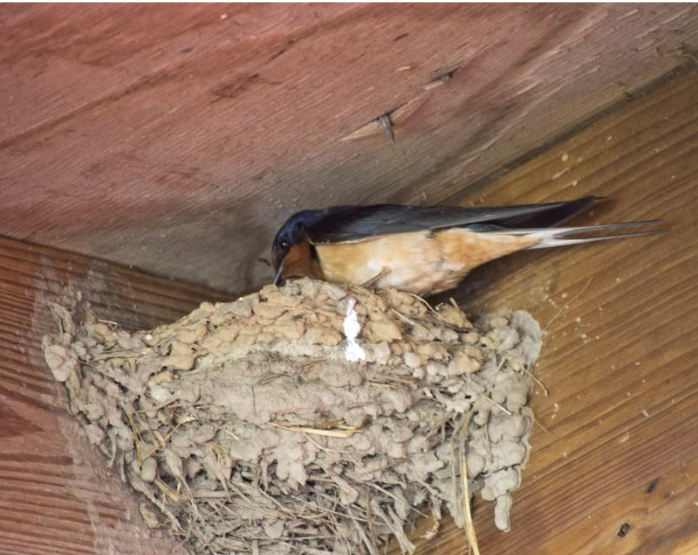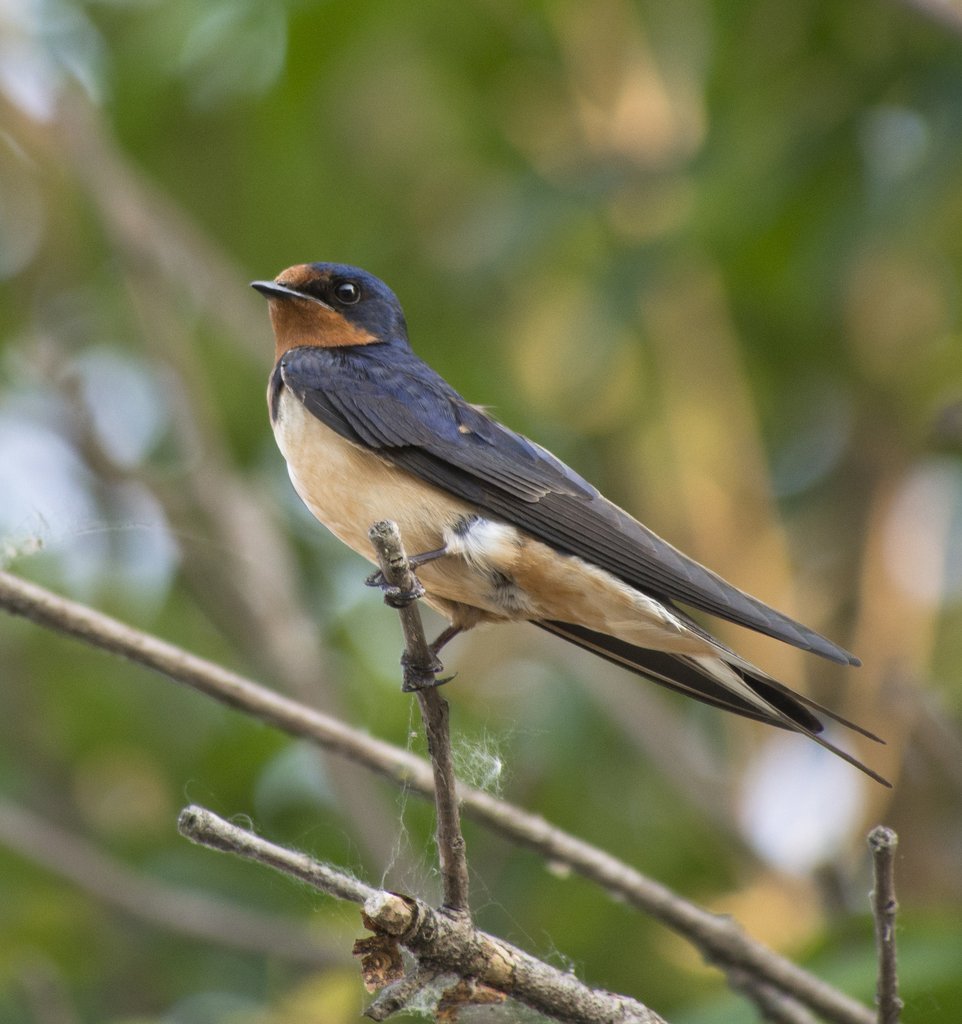Flight for Survival: An Overview of Nova Scotia's Endangered Species – the Barn Swallow
By Maya Kosick, NSEN Journalism Volunteer
Introduction
Located on the eastern coast of Cape Breton Island, the Fortress of Louisbourg National Historic Site is home to one of Nova Scotia’s endangered species–Hirundo rustica, more commonly known as the Barn Swallow. This medium-sized migratory songbird has found a seasonal home within the quiet and isolated walls of the Fortress of Louisbourg, making it an ideal nesting ground for one of the largest Barn Swallow colonies in Atlantic Canada (Fortress of Louisbourg National Historic Site, 2022). Province-wide, there are approximately 76,000 Barn Swallows, and numbers are dwindling due to habitat loss and climate change (ECCC, 2022).
Photo: A Barn Swallow sitting on a branch in front of the water (Johnson, 2023).
Habitat
Before the arrival of European settlers, Barn Swallows primarily made their nests along stony cliffsides, utilizing caves, holes, cracks, and ledges as their chosen nesting habitat (COSEWIC, 2011). However, with rapid human population growth, their nesting preferences have notably shifted from natural to artificial locations (COSEWIC, 2011). Barn Swallows have adapted worldwide to nest in or on human-made structures, which include buildings, bridges, culverts, wells, and mine shafts (Nova Scotia Department of Lands and Forestry, 2020). Barn Swallows are known to select breeding and feeding grounds in proximity to open environments, which can encompass various landscapes, including dunes, islands, large woodland clearings, marshes, diverse farmlands, and even subarctic tundra (COSEWIC, 2011). Barn Swallows prefer wet areas with access to mud, as they build their nests using mud pellets (COSEWIC, 2011). Typically, these nests are constructed on a horizontal ledge or attached to a vertical wall near an overhang, with an elevation ranging from two to five meters above the ground or water surface (Nova Scotia Department of Lands and Forestry, 2020). Barn Swallows have learned to be flexible and adaptable, allowing them to thrive in diverse habitats. While they have successfully coexisted with human development, there are many threats that they have to deal with daily.
Photo: Barn Swallow nest constructed of mud, dried grass, and feathers (Hannawacker, 2017a).
Diet
With insects making up 99.8% of the Barn Swallow diet, they rely heavily on catching insects mid-flight for nearly all their nourishment, although occasionally, they forage on the ground (ECCC, 2022). They are considered a "generalist aerial insectivore" and have showcased their varied palate by eating insects from 130 distinct insect families (ECCC, 2022, Physiology, diet, and adaptability section). Among their prey are various insects, such as grasshoppers, crickets, dragonflies, damselflies, barkflies, thrips, lacewings, true bugs, beetles, butterflies, and moths (ECCC, 2022). During adverse weather conditions like rain or high winds, the Barn Swallow adapts its diet to include berries, seeds, insects on plants or surfaces, and dead insects (Hinterland Who’s Who, n.d.). However, extended periods without access to flying insects can have severe consequences, leading to distress and even fatalities among young and adult swallows (Hinterland Who’s Who, n.d.). To mitigate this, Barn Swallows strategically adjust their feeding habits, concentrating slightly above the surface of ponds and lakes where warmer water temperatures sustain active flying insects, ensuring a continued food supply (COSEWIC, 2011). This behaviour aims to provide a continuous food supply and, therefore, avoid the detrimental effects of prolonged insect scarcity on the swallows' well-being.
Distribution and Migration
The Barn Swallow, recognized as the most widely distributed swallow species globally, inhabits every continent except Antarctica (ECCC, 2022). This avian species is a common breeder across North America, Europe, and Asia (ECCC, 2022). In the Northern Hemisphere, Barn Swallows thrive in temperate and subarctic regions. Nova Scotia lies at the eastern border of the Barn Swallow North American habitat, extending south into central Mexico and west across the Boreal Forest (Stewart et al., 2015). As a long-distance migrant, the Barn Swallow populates various parts of North and South America, establishing records across every country in these two continents (ECCC, 2022).
Interestingly, apart from a small segment of Argentina and specific areas in Central Mexico, there's minimal overlap between the breeding and wintering territories of these swallows (ECCC, 2022). In Canada, approximately 2,450,000 pairs of Barn Swallows nest from late April to early November; however, most depart the country by September and return in April (Hinterland Who’s Who, n.d.). Their southward migration can commence as early as late July in some northern regions (Hinterland Who’s Who, n.d.). Nova Scotia, estimated to host only about 1.2% of Canada's total Barn Swallow population, serves as a vital yet limited habitat for these migratory birds (ECCC, 2022). The Barn Swallow's extensive distribution across continents showcases, once again, their adaptability to diverse environments and seasonal movements.
Map: Breeding and wintering range of Barn Swallow in the Western Hemisphere (NatureServe, 2020).
Current Threats
The Barn Swallow is one of the flying insectivores that has encountered substantial population declines in North America since the 1980s (ECCC, 2022). This decline is attributed to various stressors, including intensified agriculture, declining flying insect prey, loss of nesting sites, and the influence of climate change (ECCC, 2022). Notably, breeding Barn Swallows in eastern Canada undergo significantly lengthier migrations than their western counterparts, exposing them to more pronounced threats (ECCC, 2022). Furthermore, an array of additional threats contributes to the challenges faced by Barn Swallow populations. These include water pollution, pesticide poisoning, increased mortality due to intensified and more frequent hurricanes during migration, increased nest predation by non-native predators, and the rise in adult predation from native species (COSEWIC, 2011). Even though Barn Swallows have become highly adaptable since the increase in human population, these threats underline the intricate challenges impacting their survival. Understanding and addressing these threats is crucial to protect and conserve Barn Swallows. Detailed research and conservation initiatives are key to mitigating the detrimental impacts and securing a healthier environment for the Barn Swallows.
Case Study: Barn Swallow Conservation Initiatives at the Fortress of Louisbourg National Historic Site
At the Fortress of Louisbourg National Historic Site, Parks Canada prioritizes creating a Barn Swallow-friendly environment. The staff meticulously ensures that the site contributes to the nesting habits of Barn Swallows. They recognize the historic buildings on the site as ideal habitats for these migratory birds. To encourage nesting, they deliberately keep doors open within certain buildings, allowing Barn Swallows to construct their nests in the rafters.
Furthermore, the staff has implemented recent initiatives to further support the Barn Swallows. A dedicated mud spot has been established behind one of the buildings close to the Barn Swallow nesting area. This deliberately crafted mud spot offers Swallows easy access to the essential building material they use to construct and maintain their nests. These simple yet thoughtful conservation efforts illustrate the commitment of Parks Canada to accommodate and sustain the nesting needs of these avian residents within the historically significant grounds of the Fortress of Louisbourg.
How To Help
There are numerous ways to support Barn Swallows in Nova Scotia:
Participating in the Birds Canada Project NestWatch, where individuals monitor swallow nests throughout the breeding seasons, contributes to vital data collection on Barn Swallows (Hinterland Who’s Who, n.d.).
For those interested in attracting Barn Swallows to their property, creating a welcoming nesting environment is essential. Installing shelves near the ceiling in buildings, maintaining a supply of mud, and keeping barn doors open can encourage these birds to nest on the property throughout their breeding season.
In instances where an old building must be removed, constructing a covered structure in its place offers an alternative nesting site for Barn Swallows, ensuring they have a new location to build their nests (Hinterland Who’s Who, n.d.).
Planting native plants that attract insects can aid in providing a food source for Barn Swallows, and on a larger scale, conserving and restoring wetlands and open habitats that serve as foraging grounds for these birds also contribute to their conservation efforts.
Creating awareness and educating communities about preserving habitats and minimizing threats to these species is equally crucial.
Photo: A Barn Swallow on a branch (Hannawacker, 2017b).
References
Committee on the Status of Endangered Wildlife in Canada. (2011). COSEWIC assessment and status report on the Barn Swallow Hirundo rustica in Canada. Committee on the Status of Endangered Wildlife in Canada. Ottawa. https://www.sararegistry.gc.ca/virtual_sara/files/cosewic/sr_barn_swallow_0911_eng.pdf
NatureServe. 2020. NatureServe Explorer. NatureServe, Arlington, Virginia. Website: [accessed December 2023]
Fortress of Louisbourg National Historic Site. (2022). The Fortress of Louisbourg National Historic Site is home to swallows [Status update]. Facebook. https://m.facebook.com/story.php?story_fbid=pfbid0WawaPZTf5qddmvsTXj5vZFp5Qgzu6VPjg5s1hfvXBA4A31DDDv3zFpjzXDq43n5gl&id=100064917695293&mibextid=Nif5oz
Hannawacker, Robb. (2017). Barn Swallow (Hirundo rustica) nest [Photograph]. iNaturalist. https://www.inaturalist.org/observations/6323866
Hannawacker, Robb. (2017). Barn Swallow (Hirundo rustica) [Photograph]. iNaturalist. https://www.inaturalist.org/observations/6487004
Hinterland Who’s Who. (n.d.). Barn swallow. Hinterland Who’s Who. https://www.hww.ca/en/wildlife/birds/barn-swallow.html
Johnson, Dorothy. (2023). Barn Swallow (Hirundo rustica) [Photograph]. iNaturalist. https://www.inaturalist.org/observations/165447565
Nova Scotia Department of Lands and Forestry. (2020). Recovery Plan for the Barn
Swallow (Hirundo rustica) in Nova Scotia [Final]. Nova Scotia Endangered Species Act
Recovery Plan Series. https://novascotia.ca/natr/wildlife/species-at-risk/docs/RECOVERY_PLAN_Adopted_BARN_SWALLOW.pdf
Stewart, R. L. M., Bredin, K. A., Couturier, A. R., Horn, A. G., Lepage, D., Makepeace, S., Taylor, P. D., Villard Marc-André, Whittman, R. M., & Chardine, J. W. (2015). Barn Swallow. In Second atlas of breeding birds of the Maritime Provinces (pp. 356-357). chapter, Bird Studies Canada, Environment Canada, Natural History Society of Prince Edward Island, Nature New Brunswick, New Brunswick Department of Natural Resources, Nova Scotia Bird Society, Nova Scotia Department of Natural Resources, Prince Edward Island Department of Agriculture and Forestry. https://www.mba-aom.ca/pdfs/atlas_en_330-359.pdf#page=27




